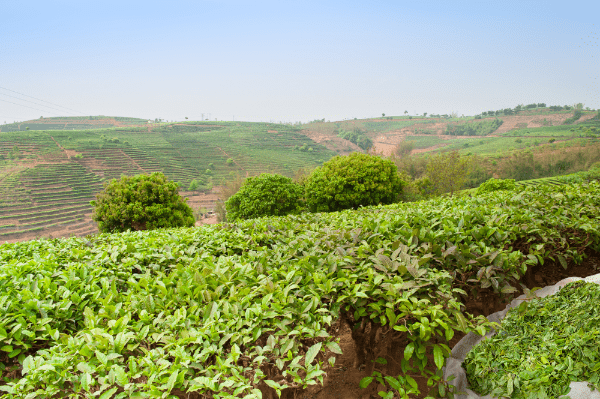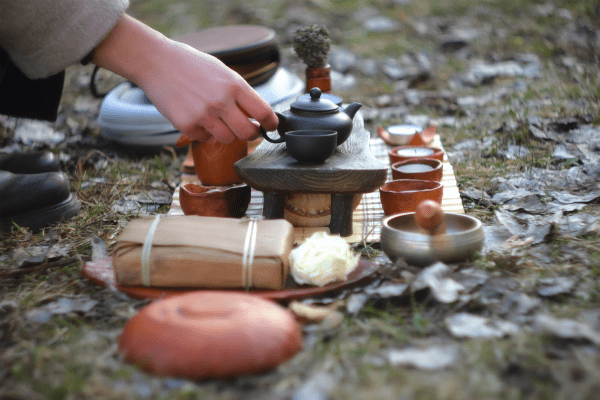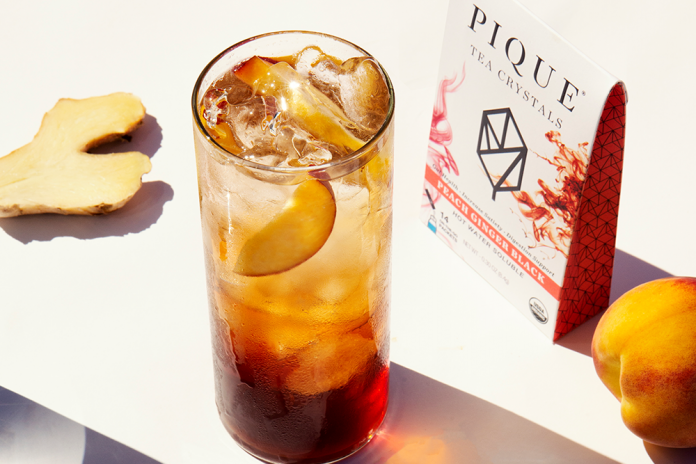Why do tea lovers say pu’er tea is unlike any other types of tea?
Pu’er tea (pronounced poo-erh) is a fermented Chinese tea with a unique flavor and ultra-high levels of polyphenols. But many people don’t know much about it.
Here in the U.S., pu’er tea has never enjoyed the same popularity it does abroad. We think that should change.
If you’re an avid tea drinker looking to expand your options beyond green, oolong, and black tea, pu’er (sometimes spelled pu-erh) may be just the brew you’re craving.
You can consider this guide your primer on pu’er – everything from its rich history and process to its taste profile, brewing method, pu’er tea health benefits and why it’s so expensive.
A Brief History of Pu’er Tea
Pu’er tea is named after Pu’er City, which is located in the Yunnan Province of China. Ancient Camellia Sinensis Assamica tea trees have been growing in this region for centuries.
They are among the tallest and oldest tea trees on the planet, and the leaves from these old trees contribute to pu’er’s special flavor. More than flavor, the vitality, and vigor of these ancient trees are the reason behind pu’er’s super high polyphenol levels – which far exceed those of green tea.
Originally cultivated and processed during the Han Dynasty (between AD 25-225), this Chinese tea didn’t spread until the Tang Dynasty period (AD 618-906) (1). Back then, traders bartered along Tea Horse Road for pu’er tea and delivered it on mules and horseback (1).
This type of tea was so prized because its fermentation meant it would not spoil on the traders’ long journeys. So pu’er tea spread even further from China to Tibet, Hong Kong, Taiwan, and Japan.

What Makes Pu’er Tea So Different From Other Teas?
Pu’er is a fermented tea. This means after the tea leaves are picked, dried, and rolled, they undergo microbial fermentation with specific molds, yeast, and bacteria which we have come to identify as ‘probiotics.’
This process:
- creates unique tea polyphenols unavailable in any other teas;
- darkens the color of the leaves, and;
- enhances their flavor.
Pu’er is the only tea that goes through this extra fermentation step.
Post-fermentation, pu’er can be compared to a fine wine that tastes better as it ages. Some vintage varieties are decades old and can sell for thousands of dollars, or as much as $5,000 per pound (2)!
How is Pu’er Tea Made?
There are two ways tea makers process pu’er leaves for sale: the traditional method and the more commercial method. Each method begins the same way – with the leaves being plucked and set out to dry (3).
Tea processors will continually rotate the leaves to ensure each is completely dry and moisture-free (3). This step also destroys any harmful plant toxins found in the leaves (3). This finished product is known as maocha.
Traditionally, the maocha is left to dry out and ferment with its own natural bacteria, yeast, and mold in storage. After extended drying time, the raw (sheng cha) tea is then compounded into cake-like discs. It can then ferment for years. This step produces variances in quality, flavor, and price, much like wine.
The Menghai and Kunming Tea Factories developed the second, more commercial way of processing pu’er in the early 1970s. It’s known as “ripened” or purposefully fermented pu’er because it speeds up the aging and fermenting process (3).
With this method, tea factories put the maocha through a step known as “pile fermentation” (3). Here, a culture similar to the natural bacteria on the leaves is added to speed up fermentation. The tea is then aged 40 to 60 days and is considered “fully ripened” pu’er (shou cha).

Raw vs. Ripe Pu’er Tea
Does it matter whether you choose to drink raw or ripe pu’er? You bet!
Not only the flavor, but also the polyphenol type (and thus, health benefits) can differ dramatically between the two. Here’s why:
In its raw form, pu’er tea (like green tea) is high in a certain type of polyphenol known as catechins. To get from raw pu-erh to ripe pu-erh , beneficial microbes (bacteria and fungi) that live naturally in the forests and on the tea leaves metabolize these catechins and transform them to another type of polyphenol – known as theaflavins. These are what give ripe pu’er it’s darker color.

While catechins are known for supporting things like immunity and skin health, theaflavins are linked to support for digestion and heart health.
Want more catechins in your life? Drink raw pu’er. Feeling the need for theaflavins? Drink your pu’er ripe. Want to make sure you have all your bases covered? Drink them both!
Raw pu’er tends to be lighter and green in color, while ripe pu’er can range from dark red to chestnut or black.
How Do You Brew Pu’er Tea?
Pu’er tea is still shipped in pressed bricks or disc-like cakes. But it can also be consumed as loose leaf tea (3). Pu’er tea is traditionally steeped in a Yixing teapot to allow for longer steeping under hotter temperatures.
To brew a cup, break off a small chunk of the pu’er tea cake and add it to your chosen teaware. Run hot water (not boiling water) over the tea leaves to “awaken” them and open up all their flavors. Then discard this water.
Next, add fresh, hot water to your cup of wet tea leaves and steep for a few minutes. Separate your brewed tea from the leaves so you can re-steep when you’re done with your initial cup. (If you’re looking for quality and flavor, we recommend staying away from tea bags.)

Pu’er tea can be steeped almost a dozen times. While the intensity of flavors and caffeine content will diminish with each steeping, you’ll still be able to enjoy several delicious cups.
It can also be served hot or cold. Just keep in mind that Traditional Chinese Herbalism says warm drinks are much easier on your stomach, so there is that to consider.
What Does Pu’er Tea Taste Like?
As far as the flavor profile, pu’er can be described as having a smooth, earthy, floral, or woodsy taste compared to other teas. Rather than the light burst of a refreshing white tea, high-quality pu’er delivers a warm, cozy brew ideal for sipping.
Raw pu’er teas (sheng cha or sheng puerh) are robust, complex, structured teas that are rich in tannins that mellow as the tea ages. Ripened pu’er (shou cha, or aged pu-erh) is a dark tea that is less tannic, has woody, earthy notes and is generally more mellow. The complexity noticeable during its raw state becomes more subtle and nuanced after oxidation.
Both will continue to change flavors, get smoother, and finish with a sweeter taste as they age. You’ll never have quite the same taste each time, which is why many tea collectors keep pu’er teas of different ages around.
However, this comforting aged tea shouldn’t taste like straight dirt or have a fishy odor. These are two signs the pu’er tea has already turned bad and should be discarded. It may also hint at poor quality issues during the aging process.
Why the Quality of Pu’er Tea Matters
Researchers found 629 bacterial and 390 fungal species on pu’er tea leaves that they studied (3). This may sound alarming, but before you stress out, it’s good to put things in perspective. After all, the human body has trillions of microorganisms of its own (4).
You shouldn’t shy away from this tea just because of its bacteria content. But you do need to choose a reputable tea source to find good quality tea.
Since there are bacteria and the tea leaves go through natural fermentation, which means the bacteria and fungi only grow further, you could wind up with a rancid batch if you’re not careful. If you’ve ever been with someone who has mentioned a bad experience with pu’er tea, they likely had a batch like this.
That’s why you should know the source of your pu’er tea and how it’s processed so you can be sure it’s safe. You’ll also want to check if the tea leaves are organic and pesticide-free. But this may also mean you’ll have to spend a little more money.
Why the Ecology of Pu’er Tea Matters
As mentioned above, pu’er tea is unique in that it starts with the leaves of ancient Camellia Sinensis Assamica tea trees. This is a different varietal species than the Camellia Sinensis plant used to make traditional black, green and white teas.
What makes the ancient Assamica varietal trees different is their size. They grow larger and live longer than traditional varietals and develop long, massive roots that reach deeper into the earth than any other tea trees. There, they absorb the trace minerals, nutrients and other beneficial compounds from deep within the earth.

Specifically in the Yunnan Province region where these trees grow, man has not interfered in the ecology and biodiversity of the soil that has sprouted these trees. They have grown wild for hundreds of years, living symbiotically with their environment, supporting the cycle of life-and-death around them, resulting in perfectly balanced nutrient-rich soil.
Why Is Pu’er Tea One Of The Most Expensive Teas In The World?
Another noteworthy feature of pu’er tea is its price tag. At one point pu’er was more expensive per gram than silver. A vintage 64-year-old batch even sold for $150,000 (9)! But why is that?
First, a difference in price could be due to where your pu’er tea leaves come from. ‘Wild arbor’ teas (or older tea trees that grow wild in forests) command much higher price tags than ‘terrace grown’ (or commercially farmed) varieties (9). Wild trees are simply rarer, in higher demand and far superior in quality.
Second, how long the tea ages and ferments can also drive up the price tag, as mentioned with the vintage batches. Just like fine wine, you’ll pay a higher premium for pu’er tea that’s been left to ferment longer.
Pu’er Tea as a Fermented Food
You know that fermented foods are a vital part of supporting good gut health. Providing your microbiome with a diverse mix of microflora is a sustainable way to help your gut health flourish.
Kimchi, miso, sauerkraut, kombucha… and now pu’er tea.
For hundreds of years, traditional Chinese herbalists have recommended pu’er tea (especially the ripe variety) as an aid to “warm the stomach” and support digestion. It supports a healthy balance of friendly bacteria in your gut.
Personally, we think you’d be hard-pressed to find a simpler, more delicious way to get your daily dose of gut-boosting prebiotics and probiotics.

Health Benefits of Pu-Erh Tea
Tea drinkers during the Han Dynasty believed pu’er tea had many beneficial therapeutic properties. It is said that it’s easier to drink more pu’er tea than other teas, because it is milder and gentler than other forms of tea. So yes, you can drink pu-erh tea every day. This is true of the Ripe versions where tannins are much more mellow.
The benefits of pu-erh tea have not yet been well studied in the U.S. Here’s what the most current research supports:
1. Helps Promote Healthy Weight Management and Heart Health
Chinese herbalists have been recommending pu’er tea for thousands of years to support digestion (and for purported help with weight loss). Pu’er tea indeed contains compounds that can support digestion and help promote healthy weight management (5). Researchers believe that pu’er tea helps to block the enzymes that trigger the body to store fat, possibly making it easier to help maintain a healthy body weight.
The enzymes in the pu’er tea also help process lipids, which is why this type of tea may support cardiovascular health and healthy cholesterol levels too. While these results are promising, this study was conducted on a small sample size. However, the outcomes show further studies of pu’er are warranted.
2. Supports Healthy, Glowing Skin
In one in-vitro study, which means cells were examined under a microscope instead of using a human participant, researchers discovered that extracts of pu’er could help boost the health of our largest organ, our skin (7).
Evidence from the study demonstrated that pu’er may protect elastin, a vital protein within our skin that’s usually damaged as we age (7). Elastin is especially important in your connective tissue and internal organs as well.
The polyphenol content (i.e., antioxidants) in large-leaf pu’er teas may be one potential reason for improved skin. Pu’er has more polyphenols than green tea (7). And it’s also loaded with catechins, a specific type of polyphenol, which are specific to skin health and protection (7).

3. May Support Healthy Blood Sugar Levels (In Mice)
Several studies on mice demonstrate that pu’er helped the mice maintain a better blood sugar balance (6).
Scientists reviewing this study praised the polyphenols, catechins, caffeine, polysaccharides, and amino acids for these positive findings (6). Again, more research is needed to confirm these results, especially in humans, but it’s still good news worth noting.
4. Potential Support for Brain Health (In Rats)
Another body of research showed pu’er could be a natural neuroprotective agent, which means it may be able to support brain health (8).
Researchers from the study learned that the pu’er could protect the rats’ nerve cells from the excitatory neurotransmitter known as glutamate (8). When too much glutamate builds up, it can be detrimental to brain health (8). How this benefit fares in humans is still up for review, but these initial findings are hopeful.
Final Thoughts on Pu’er Tea
With its characteristic flavor profile and unique fermentation process, pu’er tea will be a fantastic addition to any tea drinker’s collection. Whether your preferred way to spell it is pu-erh tea or pu’er tea, you may find it becomes a new favorite in your rotation of green, black, white, and oolong tea options.
Just like fermented foods are said to be part of a healthy diet, pu’er may also deliver potential health benefits you may feel from the inside out. But no matter which way you enjoy it, the perfect cup starts with the best quality tea leaves.







Where is the best place to buy pu er tea from?